The enrollment cliff is no longer a distant forecast. For large, established universities, the impact may still feel far off. But for many small and mid-sized colleges, the signs are already here: fewer applicants, tighter budgets, tougher conversations with leadership.
- College enrollment is projected to fall 15% from 2025 to 2029, with an additional 1-2% decline expected in the following years.
- Experts warn of a 15% plunge in college enrollments between 2025 and 2029. The crisis is looming, and some would argue it’s already arrived.
How can admissions teams respond? Technology, especially AI-powered automation, helps relieve staff pressure, engages the right students earlier, and prevents missed offers or declining yield.
AnyforSoft has spent more than 14 years building complex integrations with CRMs, SISs, LMSs, and other core systems in higher education. That experience lets us suggest proven ways forward and gives you reliable advice for navigating the 2025 enrollment cliff with confidence.
What Is the Enrollment Cliff?
The enrollment cliff is a sudden and steep drop in the number of students entering higher ed institutions. The shift is largely driven by demographic changes, most notably the decline in U.S. birth rates following the 2008 recession.

Source: McKinsey & Company
The reasons behind the college enrollment cliff
What’s pushing institutions toward this edge is a mix of long-term trends and recent shifts that have created the reality colleges face today.
- Demographic decline. The smaller post-2008 birth cohorts are now reaching college age, and there are simply fewer of them. That means a thinner pool of applicants, especially in the U.S., where enrollments could fall by 15% between 2025 and 2029. Europe faces a similar challenge, though the drop is expected to be less drastic.
- Perceived value of college. Fewer students believe higher education is worth the price. The shift is clear: in 2009, 70% of U.S. high school graduates went straight to college; by 2022, that number had dropped to 62%. Hundreds of thousands of young people are choosing alternative paths instead.
- Cost and affordability. With rising tuition and a shrinking middle class, families are questioning whether the math adds up. A Deloitte survey found that only 47% of Americans think a four-year degree pays off without loans. When loans are included, confidence plunges to 22%. Combined with accessible alternatives — trade schools, bootcamps, employer-funded training, even open-source learning — the traditional college pathway feels less compelling.
Put together, these forces are reshaping the pipeline of future students and, therefore, how university admissions should think about attracting more students.
Why you can’t ignore the demographic enrollment cliff
For colleges and universities, the real challenge isn’t just why the college enrollment cliff is happening. It’s what this drop means for their budgets, programs, and survival.
- Financial strain and tuition pressures. The shrinking candidate pool has intensified institutional competition, driving colleges to offer increasingly attractive financial packages. As a result, tuition prices fell by 5–8% in 2023–24 across U.S. institutions. Families welcome the relief, but institutions are left with thinner margins and tougher trade-offs.
- Reduction of full-pay students: The proportion of students paying full tuition dropped from 26% to 22% since 2012, with 89% now concentrated at the top 50 colleges. Mid-tier schools face the biggest impact, losing these high-revenue students while being forced to offer steep discounts to fill enrollment gaps.
- Program cuts and faculty reductions. Some institutions are adjusting by scaling back academic offerings and staff. West Virginia University cut 28 programs and 147 faculty in 2023 to cover a $45 million shortfall. Another example is the University of Wisconsin–Milwaukee that reduced 32 faculty positions after a 16% enrollment decline.
Not all institutions face this academic cliff with equal footing. Highly selective universities with strong brands and large endowments continue to attract record applications, drawing from a global pool. The greater strain falls on mid-tier private colleges, small liberal arts schools, and regional public campuses that recruit locally.
How enrollment losses impact different institution sizes (Figures are hypothetical examples for illustration)
| Factor | Large University (20,000 students) | Small College (1,000 students) |
| 100-student loss impact | 0.5% enrollment drop | 10% enrollment drop |
| Revenue sources | Tuition, research grants, endowment income, corporate partnerships, alumni donations | Primarily tuition-dependent |
| Debt burden | 40% debt-to-revenue ratio ($200M debt / $500M annual revenue) – High flexibility to adjust across many programs and revenue sources | 50% debt-to-revenue ratio ($15M debt / $30M annual revenue) – Low flexibility, fewer options, higher risk of financial distress |
Admissions offices carry the heaviest load. Staff walk into meetings fielding questions like:
- “Why did our yield drop 3% this semester?”
- “How do we explain losing 15% of our target demographic?”
- “What’s the plan to get our conversion rates back on track?”
The questions keep coming, but the resources to answer them don’t. We believe technology can provide the solution.
Risks for Admissions Offices
The enrollment cliff 2025 creates operational challenges for admissions offices. These departments face reduced efficiency and growing bottlenecks in their daily work.
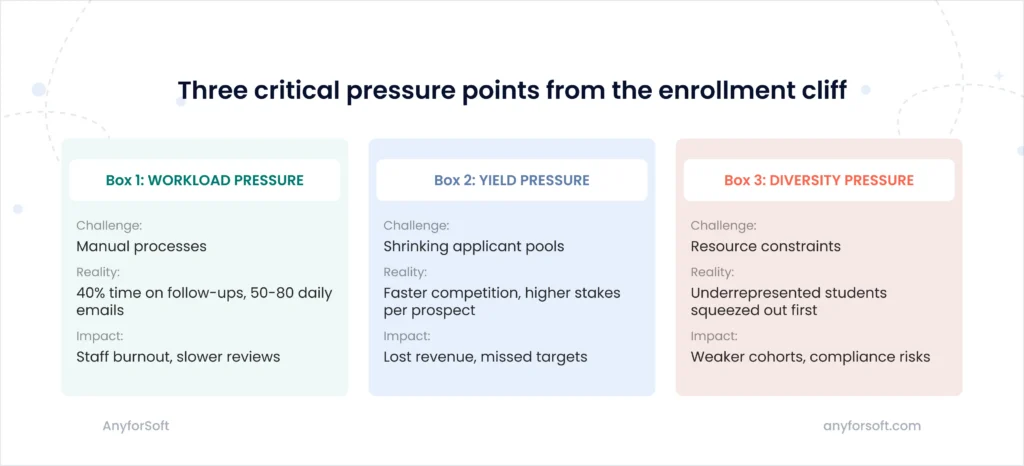
Overworked staff and slower application review
The most immediate strain in admissions is the workload staff are asked to manage. Applicant pools may be shrinking, but reviews are becoming more complex, files more incomplete, and deadlines tighter.
To understand how this plays out on the ground, AnyforSoft ran a survey of admissions staff across 744 colleges to map their biggest enrollment workflow challenges. The responses painted a clear picture of offices already operating at the limit as the demographic cliff in higher education intensifies operational pressures.
Managers report spending up to 40 percent of their day on manual follow-ups. Add inboxes that are flooded with 50 to 80 emails a day asking for status updates
- “Has my documentation been received?”
- “Can you verify my application file is complete?”
- “Did my transcript arrive?”
Many institutions still juggle spreadsheets and shared folders to organize applications, creating bottlenecks that slow down every review cycle.
As one admissions officer put it in our survey:
“Here we are in 2025, still managing contracts manually and storing applicant data in Excel files.”
For many teams, the daily grind feels like trying to keep water out with a sieve. It’s constant effort with little progress.
And that is the heart of the problem: talent and attention are drained by repetitive work instead of directed to shaping the cohort. When you think of possible solutions, automation probably comes to mind. The real question becomes: how do you automate without losing the human touch? The answer, increasingly, is found in two letters — AI.
Missed offers and lost yield
Missing an applicant doesn’t just mean one empty seat anymore. Under the 2026 enrollment cliff, each offer carries more weight, and the margin for error is razor thin. Students are applying broadly, and if one institution is slow to follow up or unclear with next steps, another is ready to step in. Yield is no longer just a percentage on a dashboard — it’s the frontline measure of whether an institution can stay financially stable.
The admissions cliff intensifies the risks in several ways:
- A smaller applicant pool means fewer chances to make up for lost prospects.
- Longer review cycles increase the odds that offers arrive too late to compete.
- Communication gaps leave high-potential students disengaged before decisions are even made.
- Every missed candidate has a magnified impact on cohort size, tuition revenue, and diversity balance.
It works like a snowball: small inefficiencies multiply into visible losses. That’s why many leaders at colleges and universities are starting to look at how technology can help safeguard yield quality.
At Oxford University, workflow automation cut the manual steps per application by half. Artificial Intelligence implementation changed admissions staff managers dramatically, turning them from routine processors to strategists who can concentrate on shaping the incoming class.
Declining diversity pools
What if we think of diversity in admissions like nutrients in soil? Lack the nutrients, and nothing truly flourishes.
In a diverse classroom, debates come alive. Different mindsets cross-pollinate ideas; as a result, a vibrant atmosphere attracts top talent. But the enrollment cliff puts all of this at risk.
As candidate pools shrink, guess who gets squeezed out first? Underrepresented and economically vulnerable students. These are often the same school graduates who bring fresh perspectives and strengthen academic communities but may lack the resources to navigate complex application processes quickly.
Candidate pools compared
| Criterion | Admissions Pool With Diversity | Admissions Pool Without Diversity |
| Classroom dynamics | Rich discussions from varied backgrounds | Limited perspectives, weaker problem-solving |
| Institutional reach | Global visibility through international students | Local focus narrows appeal |
| Campus culture | Inclusive environment supports equity goals | Reputation risks from skewed demographics |
| Alumni impact | Strong networks boost funding potential | Narrow pipelines limit donor base |
When applicant pools shrink, diversity efforts often suffer first.
- Outreach to harder-to-reach communities slips down priority lists.
- Scholarships get concentrated on fewer groups.
- International recruitment becomes riskier with visa complications.
The result is far from being upbeat. Smaller, less diverse cohorts simply weaken the institution’s foundation.
Technology can’t replace commitment to diversity, but it can help nourish it – if you use it with a strategy in mind.
Attracting More Students: AI for Enrollment Growth
Optimization helps you work smarter with existing prospects, but what about expanding that pool? The second half of the 2025 college enrollment cliff solution focuses on drawing more students into your funnel.
AI doesn’t just streamline what you have. It helps you find and convert prospects you never knew existed.
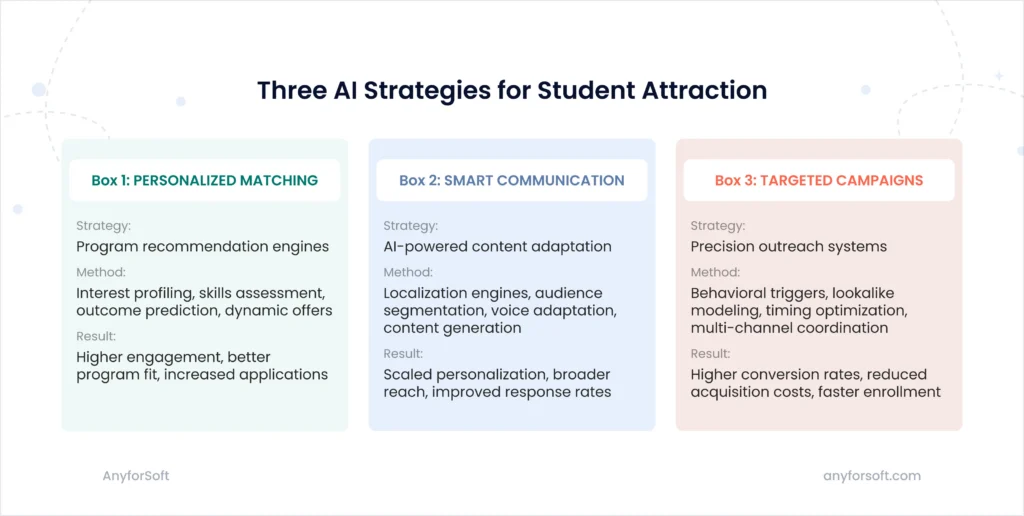
Personalized program matching and offers
Many students arrive at your website exploring their options. They’re weighing different programs, comparing outcomes, and trying to find the best fit for their goals. AI can guide this exploration by becoming the always-available advisor who helps them discover possibilities they might have missed.
AI can support this exploration in several practical ways:
- Interest profiling — track which program pages students visit, how long they stay, what they download.
- Skills assessment integration — connect aptitude tests and career surveys to program recommendations.
- Outcome prediction — show students career prospects and salary data for programs that match their profile.
- Dynamic offers — adjust financial aid packages based on likelihood to enroll and program fit.
Instead of generic brochures, students get personalized program suggestions that feel like they were created just for them. A student browsing engineering pages but spending more time on design content might see recommendations for industrial design or user experience programs they hadn’t considered.
At AnyforSoft, we’ve seen this approach work with structured and unstructured data analysis. Students leave digital breadcrumbs across your site, and AI can interpret those patterns to suggest the programs most likely to capture their interest and lead to enrollment.
This requires sophisticated higher education website development that tracks and analyzes user behavior effectively.
AI-powered content and communication
Your message needs to reach students where they are, in languages they understand, with content that resonates. AI makes this possible at scale without losing the personal touch.
Communication automation solutions include:
- Localization engines — automatically translate and culturally adapt content for international prospects.
- Audience segmentation — messages are tailored for first-generation college students, career changers, or international applicants.
- Voice adaptation tools — adjust tone and complexity based on prospect demographics and engagement history.
- Content generation tools — create personalized email sequences that reference specific programs, campus features, or financial aid options.
The result feels like personal attention even when serving thousands of prospects.
Targeted outreach campaigns
Traditional outreach casts wide nets and hopes for the best. AI-powered campaigns work more like precision fishing: they target exactly the prospects most likely to be engaged.
Smart campaign strategies include:
- Behavioral triggers — contact students who downloaded specific materials but didn’t complete applications.
- Lookalike modeling — find prospects similar to your most successful current students.
- Timing optimization — reach out when prospects are most likely to respond based on engagement patterns.
- Multi-channel coordination — synchronize email, phone, and social media outreach for maximum impact.
Consider the student who downloads your nursing program brochure but doesn’t apply. Traditional follow-up might be a generic email weeks later. AI-driven outreach could trigger a personalized call within 48 hours from an admissions counselor with nursing expertise. Moreover, it’s followed by targeted social media content about career outcomes for your nursing graduates.
Maximizing What You Have: AI for Admissions Optimization
Admissions teams feel the education cliff impact most directly in their daily operations. Staff are stretched thinner while the stakes for every decision climb higher. Here’s where the pressure shows up most clearly.
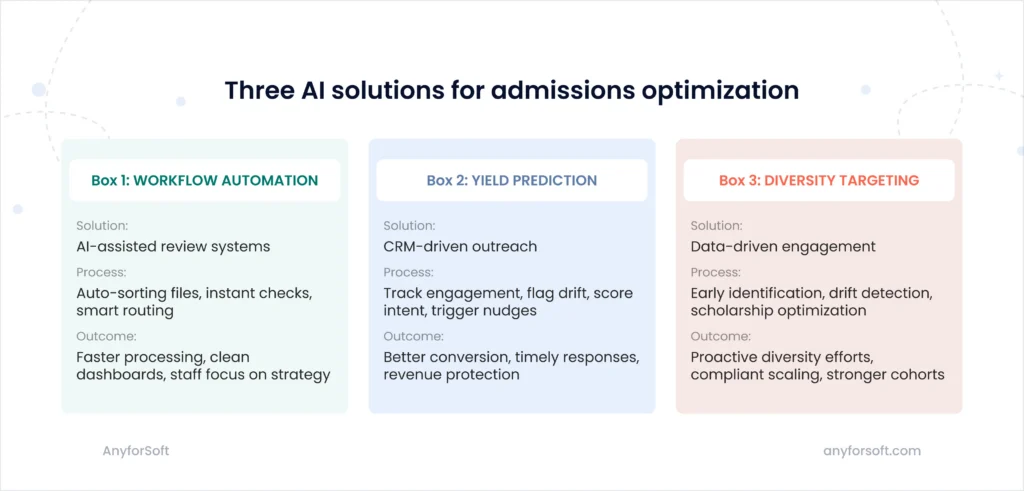
Smarter workflows and AI-assisted review
Application review drives admissions, but under enrollment pressure, it crawls when it should sprint. Every delay means losing candidates to faster competitors.
AI handles the routine work that bogs down your team:
- Auto-sorting files — transcripts and test scores land where they belong
- Instant completeness checks — students get reminders before gaps become problems
- Document verification — flags suspicious materials without human review
- Smart routing — pushes standard cases forward, escalates complex ones to staff
Students get instant confirmation when they upload documents. Your team sees clean dashboards instead of wrestling with Excel spreadsheets.
At AnyforSoft, we connect your existing systems so they work as one unit through custom education software development. AI tools integrate with your current SIS, LMS, and CRM, letting one application upload trigger checks across all platforms and update student records automatically. Staff never touch files manually.
Agentic AI goes further by managing entire decision chains without constant oversight.
As our CTO Oleg Bogut explains: “These systems review, categorize, route, and escalate applications through complete workflows, stopping only when human judgment is actually needed.”
Predictive yield modeling and CRM-driven outreach
The 2025 college enrollment decline makes yield critical. Students pick the fastest responders from a shrinking pool. AI systems help you predict and prevent revenue losses before they happen. Here’s how they work in practice:
- Tracking engagement — portal visits, event attendance, email opens
- Flagging drift — students at risk of accepting elsewhere
- Scoring intent — helping staff focus energy where it counts
- Triggering nudges — document reminders to scholarship follow-ups
At AnyforSoft, we connect your existing systems so they work as one intelligent unit. Our CRM for higher education integrations turn scattered data into a single dashboard that automatically sends the right message to the right student at exactly the right moment.
Looking at outcomes from our portfolio, the results can be quite promising. In our work with projektmagazin, external tools integration resulted in an 18% increase in website traffic, 31% improvement in site speed, and 10% growth in subscribers.
Your admissions operation could see comparable transformation.
Data-driven targeting and inclusive engagement
AI-powered targeting helps sustain diversity while managing tight resources. Instead of broad campaigns that stretch staff thin, technology focuses attention where it matters most.
Here’s how this works:
- Early identification — spot underrepresented applicants sooner
- Drift detection — catch students pulling away before they disappear
- International streamlining — automated translation and credential mapping
- Scholarship optimization — find which aid strategies actually drive yield
Benefits multiply: diversity efforts become proactive, communications hit at the right moment, and real-time dashboards replace weeks of spreadsheet analysis. As the demographic cliff in higher education makes every prospect more valuable, these tools help institutions maintain diverse cohorts without overwhelming admissions staff.
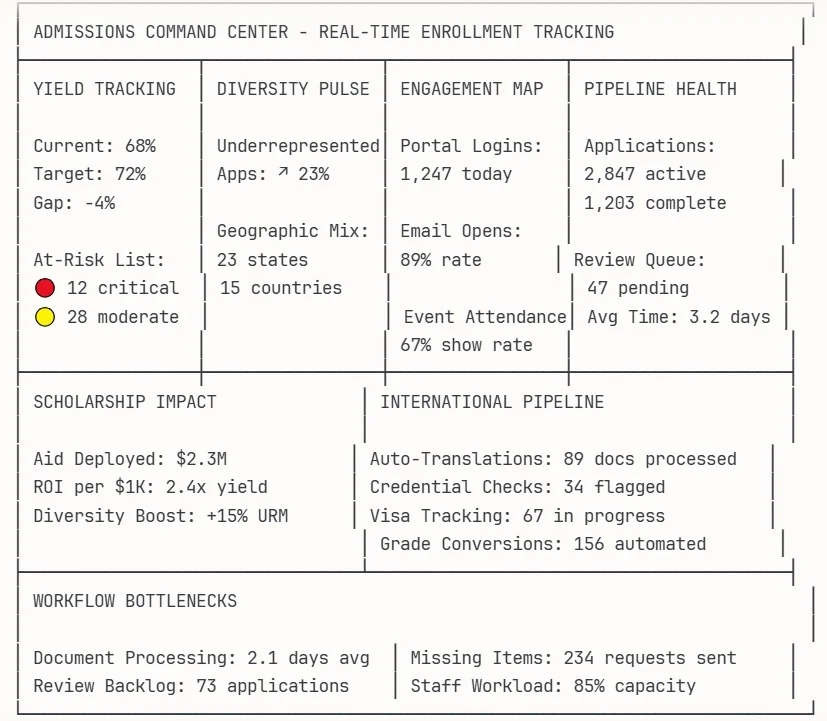
AnyforSoft builds security and privacy protections into every integration. We ensure GDPR and FERPA compliance through role-based access controls and automatic audit trails without extra staff work, addressing potential AI privacy risks from the ground up.
This balance lets admissions teams scale outreach without sacrificing trust, keeping cohorts diverse even when every enrollment decision carries higher stakes.
Real-World Admissions Tech in Action
AI implementation looks different at every institution, but these three universities show what’s possible when you match technology to your specific challenges.
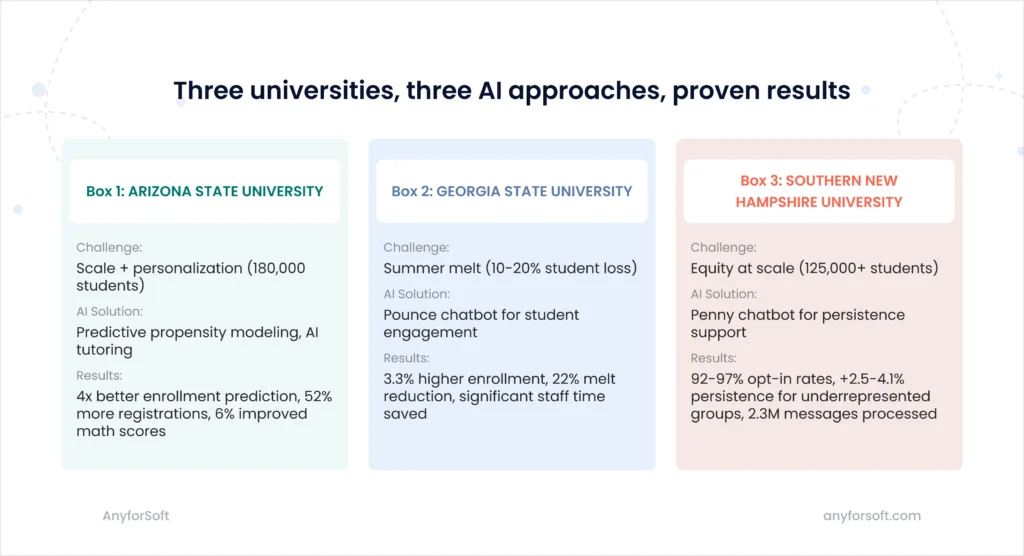
Arizona State University: digital-first admissions strategy
Arizona State University handles over 180,000 students across physical and virtual campuses. The challenge? Making every prospect feel seen at a massive scale.
ASU’s EdPlus division built AI into their enrollment process, analyzing conversations from enrollment centers alongside student web activity to create smarter propensity models.
Their implementation produced the following outcomes:
- 4x improvement in predicting enrollment likelihood.
- 52% increase in registrations compared to conventional lead scoring.
- 6% boost in correct math answers with AI tutor Archie, helping future students build confidence before admission.
ASU proves that scale doesn’t have to sacrifice personalization. Their approach shows how predictive modeling can transform raw data into enrollment growth.
Georgia State University: AI chatbot to improve yield and engagement
Georgia State University faced the dreaded summer melt — 10% to 20% of admitted students never showed up in fall despite accepting offers. Their solution was Pounce, an AI chatbot that texted students about financial aid forms, transcripts, and other requirements (a prime example of how universities are using chatbots to improve student engagement).
Pounce delivered measurable impact:
- 3.3% higher enrollment among students who received chatbot outreach.
- 22% reduction in summer melt.
- Significant staff time saved by handling repetitive questions automatically.
GSU’s success lies in timing and tone. By reaching students during the vulnerable summer months with friendly, peer-like communication, they turned potential dropouts into enrolled students.
Southern New Hampshire University: scaling admissions with AI support
SNHU serves 125,000+ students through AI-powered automation. Their chatbot “Penny” guides students through enrollment steps while staff focus on high-touch advising.
The implementation generated the following results:
- 92-97% of students opted in to continue receiving AI nudges.
- Persistence rates improved: +2.5% for Black students, +3.5% for Hispanic students, +4.1% for other non-white students.
- Over 2.3 ƒ messages processed without overloading staff.
SNHU demonstrates how AI can advance equity at scale. Their focus on underrepresented student success shows that automation enhances the human touch rather than replacing it. This matters most for students who face extra hurdles in their educational journey.
Conclusion
The enrollment landscape is shifting, creating new challenges for admissions teams everywhere. Smaller applicant pools mean every interaction matters more, while manual processes that once worked fine now create bottlenecks that cost real opportunities.
Smart institutions are already adapting. They’re using technology to work more efficiently with existing prospects while simultaneously expanding their reach to new student populations. The universities implementing these changes are seeing better outcomes without overwhelming their staff.
The question isn’t whether change is coming. It’s whether you’ll be ready when it arrives.
FAQs
Small colleges can’t match big universities on scale. They need to win on speed and personal attention instead. AI workflows help tiny teams respond as fast as much larger ones, while predictive modeling shows exactly which prospects deserve your limited time and energy.
Start small. Focus on connecting what you already have rather than buying entirely new systems. Most schools see payback within one enrollment cycle. High-impact solutions like CRM automation and better workflows often cost less than you’d expect and deliver results quickly.
It is happening right now. High school graduations peaked in 2025. College enrollment projections show they’ll decline significantly over the next two decades, with the steepest drops hitting in the late 2020s. Current education statistics confirm these trends across most regions. Some areas will hurt more than others, but no institution should wait for demographics to improve.
Small colleges face the biggest threat. Losing 100 students barely dents a large university but devastates a school with 1,000 total enrollment. Private colleges that depend on tuition revenue are especially vulnerable. Regional schools that recruit locally have fewer options than institutions with national reach, particularly given projected demographic shifts in rural areas.
Smart CRM systems watch how prospects behave and respond accordingly. They know which students visited your engineering pages three times this week. They send the right message at the right moment. Automated workflows catch prospects before they slip away, turning more inquiries into actual applications.








